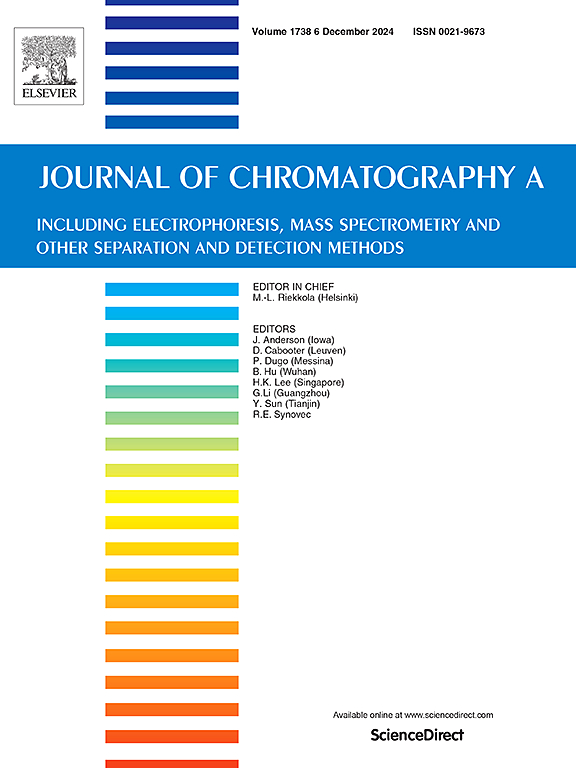Custom GC×GC configuration for the selective isolation or removal of compounds from complex samples
IF 3.8
2区 化学
Q1 BIOCHEMICAL RESEARCH METHODS
引用次数: 0
Abstract
We developed a novel approach to selectively isolate or remove nearly any compound from complex mixtures of volatile organic compounds. This was achieved by customizing a GC×GC system with a Deans switch, a passive splitter, and a custom-made adapter for sample recollection. The new setup was evaluated with 106 standard chemicals covering a wide range of volatility (boiling points: 56 – 343 ⁰C) and polarity (log P: 0.2 – 9.4). The method was used to remove two notorious malodorous compounds from spoiled wine samples. We found that the recovery can be maximized if a custom-made adapter is attached directly on the flame ionization detector port (average recovery rate of 76 ± 7 % for the standards). Eventually, we could selectively isolate or remove chemicals with peaks separated by a minimum distance of 50 ms for the second column throughout the whole chromatographic run. The developed system is expected to mainly be used in the field of flavor and fragrance analysis (i.e., selection of flavors and odorants of interest or removal of off-flavor or malodorous compounds). At present, we can reasonably collect about 100 ng of each single compound and are currently working on sample enrichment to improve our method to isolate sufficient amounts for further chemical analysis (e.g. high sensitivity nuclear magnetic resonance or chemical ionization tandem mass spectrometry).
定制 GC×GC 配置,用于从复杂样品中选择性地分离或去除化合物。
我们开发了一种新方法,可从复杂的挥发性有机化合物混合物中选择性地分离或去除几乎任何化合物。这是通过定制带有迪恩斯开关、无源分流器和定制样品收集适配器的 GC×GC 系统实现的。使用 106 种标准化学品对新装置进行了评估,这些化学品的挥发性(沸点:56 - 343 ⁰C)和极性(log P:0.2 - 9.4)范围很广。该方法用于去除变质葡萄酒样品中两种臭名昭著的恶臭化合物。我们发现,如果在火焰离子化检测器端口上直接安装一个定制的适配器,可最大限度地提高回收率(标准品的平均回收率为 76 ± 7 %)。最终,我们可以在整个色谱运行过程中,选择性地分离或去除第二色谱柱上色谱峰分离距离最小为 50 毫秒的化学物质。所开发的系统预计将主要用于香精香料分析领域(即选择感兴趣的香精香料或去除异味或恶臭化合物)。目前,我们可以合理地收集约 100 纳克的单个化合物,并正在进行样品富集,以改进我们的方法,分离出足够数量的化合物,用于进一步的化学分析(如高灵敏度核磁共振或化学电离串联质谱)。
本文章由计算机程序翻译,如有差异,请以英文原文为准。
求助全文
约1分钟内获得全文
求助全文
来源期刊

Journal of Chromatography A
化学-分析化学
CiteScore
7.90
自引率
14.60%
发文量
742
审稿时长
45 days
期刊介绍:
The Journal of Chromatography A provides a forum for the publication of original research and critical reviews on all aspects of fundamental and applied separation science. The scope of the journal includes chromatography and related techniques, electromigration techniques (e.g. electrophoresis, electrochromatography), hyphenated and other multi-dimensional techniques, sample preparation, and detection methods such as mass spectrometry. Contributions consist mainly of research papers dealing with the theory of separation methods, instrumental developments and analytical and preparative applications of general interest.
 求助内容:
求助内容: 应助结果提醒方式:
应助结果提醒方式:


